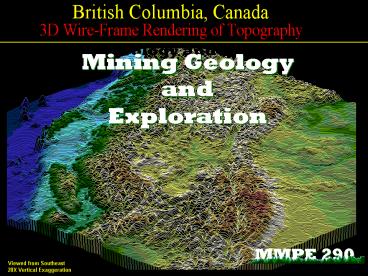Mining Geology and Exploration - PowerPoint PPT Presentation
1 / 17
Title:
Mining Geology and Exploration
Description:
... occurring compound having a definite chemical composition. Examples: ... Concentration of minerals caused by high temperatures and pressures near intrusions ... – PowerPoint PPT presentation
Number of Views:4779
Avg rating:3.0/5.0
Title: Mining Geology and Exploration
1
Mining Geology and Exploration
Mining Geology and Exploration
MMPE 290
2
Plate Tectonics and mineral deposition.
MMPE 290
3
Mining Geology and Exploration
- How much metal is available?
- What is a mineral? What is ore?
- How do ore deposits form?
- Mining exploration methods
- Role of exploration in mining
- Case histories
4
Economically Important Metal Concentrations in
Earths Crust
Note for comparison Silicon 28 Oxygen 46
5
What is a mineral?
A solid naturally-occurring compound having a
definite chemical composition Examples quartz -
SiO2 (an oxide) hematite - Fe2O3 (another
oxide) chalcopyrite - CuFeS (a sulphide)
6
What is an orebody?
An occurrence of minerals or metals in
sufficiently high concentration to be profitable
to mine and process using current technology and
under current economic conditions.
7
What is ore grade?
Ore grade is the concentration of economic
mineral or metal in an ore deposit.
- Weight percentage (base metals)
- Grams/tonne or oz/ton (precious metals)
8
Economically Important Metals Typical
Ore Deposit Average Grades
9
What does it take to be an ore deposit?
10
Hydrothermal Ore Deposits
As magma cools, more abundant metals (silicon,
aluminum) deposit first Solidification of magma
releases water - a hydrothermal solution Minerals
precipitate from hydrothermal solution and
deposit in cracks or veins in rock
11
Metamorphic Ore Deposits
Concentration of minerals caused by high
temperatures and pressures near
intrusions Examples Lead-zinc deposits in
southeast B.C. Diamonds Garnets
12
Hydrothermal and Metamorphic Ore Deposits
zoning
13
Sedimentary Ore Deposits
Deposition of dense, resistant minerals in
streams, lakes etc (Alluvial Deposits),
e.g. Placer gold Precipitation of minerals from
lakes-oceans (Evaporite Deposits), e.g. Potash
and Salt Deposits Accumulation, burial and
petrification of vegetation, e.g. Coal Deposits.
14
Exploration Methods
- Remote sensing
- Geological mapping
- Geophysical surveys
- Geochemical surveys
- Bulk sampling
- Drilling (core or destructive)
15
Airborne Geophysics
16
GEOPHYSICAL METHODS
17
Geochemical Anomalies































